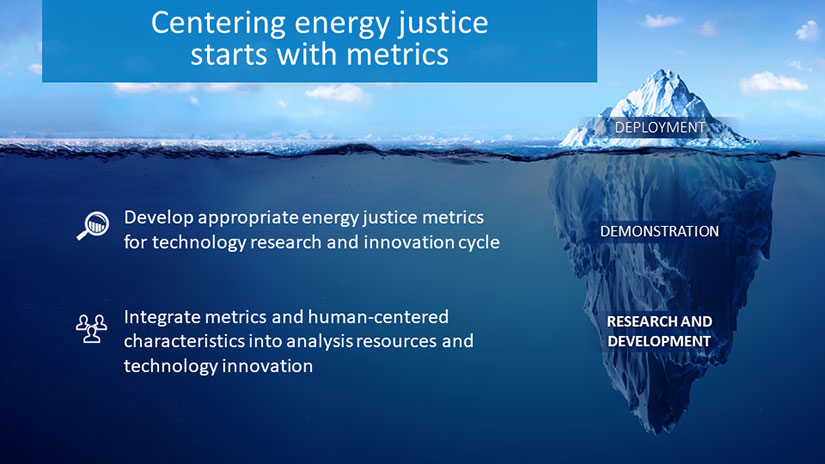NREL Draws on Experience To Expand Equitable Energy Access to State, Local, and Tribal Communities
March 29, 2021
Clean energy is clearly the future, but currently it is not accessible to everyone. NREL is committed to continue efforts to expand energy access deeper into communities and address energy inequities.
Recent trends in U.S. renewable energy generation capacity reveal stunning gains in clean energy adoption—along with significant gaps in equity.
Take solar PV, for example. According to a Lawrence Berkeley National Laboratory report, in 2018, nearly 60% of all new U.S. solar capacity was utility-scale PV, expanding access to clean, renewable energy. Yet economic benefits such as lower costs are rarely transferred directly to customers who need them most.
The deeper one digs, the wider the gaps:
- Black-majority census tracts installed 69% less rooftop PV than no-majority tracts of same median household income according to a Nature Sustainability article.
- Less than half of U.S. community solar projects include low-income households according to a Yale University article.
- Since 2006, 90% of electric vehicle income credits, according to a Tax Policy and the Economy article, were received by the top income quintile.
- Renters and those living in multifamily housing often lack access to home charging locations, where 80% of electric vehicle charging occurs according to the U.S. Department of Energy.
As the only national lab dedicated exclusively to clean energy research and development, demonstration, and deployment, NREL is well positioned to partner with communities to develop culturally responsive and adaptive strategies for clean energy deployment.
Defining Equity
When we talk about equity in the space of environment, energy, and climate, there are innumerable challenges to resolve. Ultimately, each community will define what equity means to its local needs. To get a broad sense, we quote the Initiative for Energy Justice and what stepping up to the plate in equity means. Equity means:
- Recognition and remediation of the disproportionally high and adverse human or health or environmental effect on communities of color and low-income communities
- Achieving both social and economic participation in the energy system while remediating social, economic, and health burdens of those historically harmed by the energy system
- Remediation of the impacts of climate change on poor or underserved communities and compensation for harms suffered by such communities due to climate change.
Clean energy technologies such as solar panels, electric vehicles, and intelligent data management systems are often seen as solutions that can benefit society as a whole and transition the U.S. to a clean energy economy. However, for some communities, these technological approaches are not currently compatible with their socioeconomic, institutional, and environmental realities and can disproportionately burden some groups while benefiting others, worsening inequality and injustice. Targeting investments in clean energy solutions to prioritize environmental and climate justice is a key national priority.
Developing a Path to an Equitable Energy Future
NREL has worked with more than 2,000 communities, utilities, and businesses within state, local, and tribal jurisdictions pursuing clean energy visions. The research, analysis, and technical assistance NREL provides through these partnerships informs holistic, community-driven energy and infrastructure solutions that incorporate policy, technology, economic, and social issues. Through this applied research and sustained community engagement, the lab continues to gain invaluable lessons and insights about the technical feasibility of community-centric energy transitions.
Technology deployment is only the tip of the iceberg. Equitable energy transitions must embed environmental, energy, and climate justice every step of the way in the transition process. Collaborative development of culturally responsive and adaptive technologies, strategies, and solutions enables communities to capture transformative innovations to best fit their needs. Building upward from local communities, with time, will achieve broad deployment and distribution of clean energy benefits nationally.

Heading up these efforts at NREL are lab program managers Elizabeth Doris and Roderick Jackson, along with Bruno Grunau, regional director of NREL's Arctic-focused Cold Climate Housing Research Center. With deep experience partnering with underserved, urban, rural, and remote communities, these three leaders bring passion, knowledge, and insights to labwide initiatives aimed at building on their groundbreaking work to benefit more communities.
Through community-based programs and projects that prioritize stakeholder engagement while leveraging the lab's robust analytics, models, tools, and data sets to inform innovative solutions and actionable plans, NREL has proved bold energy goals are achievable.
In the process, the lab continues to develop replicable frameworks for high-impact energy initiatives that can be scaled across geographic regions and communities.
NREL Promotes Equitable Energy Systems To Enhance Quality of Life
NREL continues to support and launch new projects that address energy inequity. The following examples highlight some of the ongoing efforts to expand energy to all communities.

Los Angeles has embarked on an ambitious plan to modernize its electricity system infrastructure—aiming for a 100% renewable energy supply by 2045, along with aggressive electrification targets for buildings and vehicles. NREL's rigorous, integrated engineering-economic analysis has informed the LA100 strategy, which is leading the way for other U.S. local governments seeking to transform their energy economies. Learn more about NREL's work with LA100.
As a partner in the U.S. Department of Energy (DOE)-led Energy Transitions Initiative Partnership Project, NREL is part of a network of experienced technical assistance providers working alongside some of the nation's most vulnerable communities. The partnership combines deep energy sector experience with specialized local expertise to address energy challenges, increase resilience, build capacity, and accelerate the sharing of best practices and innovations. Learn more in NREL's news story about the cross-sector initiative.
NREL is poised to scale up the Energy Transitions Initiative Partnership Project model, applying a bottom-up approach to achieve resilient, equitable energy transitions that integrate environmental justice, energy equity, and climate justice at every stage.
Our approach aims to create a virtuous circle of research and development, analytic capabilities, and on-the-ground partnerships that we can leverage for fast scaling of clean energy for all, which is the Accelerating Clean Energy initiative.NREL works with Native American tribes and Alaska Native villages to achieve their energy, environmental, security, and economic goals. NREL—along with funding partners, and support from the DOE's Office of Indian Energy—provides technical assistance and decision support, helping these communities meet their goals. Learn more about NREL's decision support options for tribes.
NREL continues to provide support to DOE's Weatherization and Intergovernmental Program, including its DOE Weatherization Assistance Program (WAP). The WAP helps reduce energy costs for low-income households by increasing the energy efficiency of their homes while ensuring their health and safety. Along with targeting a key economic stressor for underserved communities, WAP creates employment opportunities.
As part of a multiyear planning effort for Puerto Rico, launched in the aftermath of hurricanes Irma and Maria in September 2017, NREL is partnering with DOE and four other national laboratories to provide Puerto Rico with tools, training, and modeling support. The effort supports local stakeholders with proactive planning and operation of the electric power grid to bolster resilience against future disruptions. Learn more about NREL's role in planning support for Puerto Rico.
Additional Research and Project Highlights
These projects are just a few of NREL's exemplary work to build a more efficient future for all communities. Additional resources include:
From Lab to Tundra: Building a More Efficient Future with Rural Alaska
NREL Analysis Informs Equitable Clean Energy Transitions in Kingston, New York
Expanding Accessibility of Energy Modeling in Hawaii
Tools and Resources
NREL continues to build the foundation of equitable energy transitions through research and development, as well as accessible tools and resources for jurisdictions and communities to use to visualize their own goals.
SLOPE: State and Local Planning for Energy Platform
LEAD: Low-Income Energy Affordability Data Tool
Explore more data and tools.
NREL is proud of the work that has already been done and will continue to work toward expansion of equitable energy systems around the world.
Learn about additional projects and partnerships, where NREL is working to advance clean energy to all communities, on our State, Local, and Tribal Governments website.
Share
